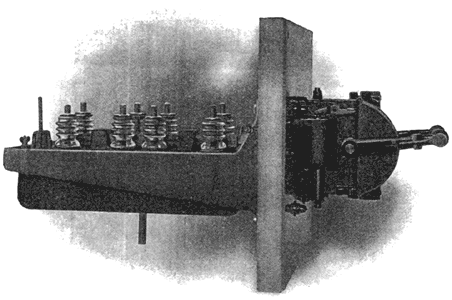[Trade Journal]
Publication: Western Electrician
Chicago, IL, United States
vol. 35, no. 18, p. 355, col. 3
Oil Switch for High Voltages.
The accompanying illustration shows a form of oil switch which has been developed by the Stanley Electric Manufacturing Company. It is of the horizontal-break type, and the arc when drawn is carried upward by the generated gases, increasing in length and breaking just below the surface of the oil.
The switch is furnished complete with oil and tank. The breaking distance corresponds to the company's standard practice at the lower voltages. For the higher voltages, however, the breaking distance is increased by multiplying the number of breaks, thus distributing the arc.
Both fixed and moving contacts are disk-shaped, with founding edges, and are interchangeable. When the switch is opened, arcing takes place between these rounded edges rather than from the flat portions which form the contact surfaces. By thus providing arcing points, good contact services are maintained at all times.
 |
| Oil Switch for High Voltages. |
From the back of each disk extends a threaded projection, which, in the case of the fixed contacts, screws directly into the ends of hollow studs. In the moving contacts, however, two nuts secure each to a connection strip. This construction facilitates removal, and the expense of replacing the disks is trifling.
The rounded edges after long use become damaged by the arc, and perfect edges can be easily brought into play by giving the disks a partial turn. As the disks may be turned to six or seven different points before requiring renewal, the life of the switch is increased several times, and the cost of repairs decreased accordingly.
The fixed contact disks are held against the lower ends of the insulators by hollow studs into which they screw. The lead wires are soldered into the top of these studs, insuring good connection.
By means of ball joints, the moving-contact disks are mounted upon the carriers, which are rigidly attached to the driving rod. These disks are self-aligning in regard to the fixed disks against which, when the switch is closed, they are pressed by strong coil springs, eliminating all possibility of poor surface contact.
These switches are made for pressures of 2,500 and 6,600 volts and may be used in connection with overload time-limit or reverse-current relays.
